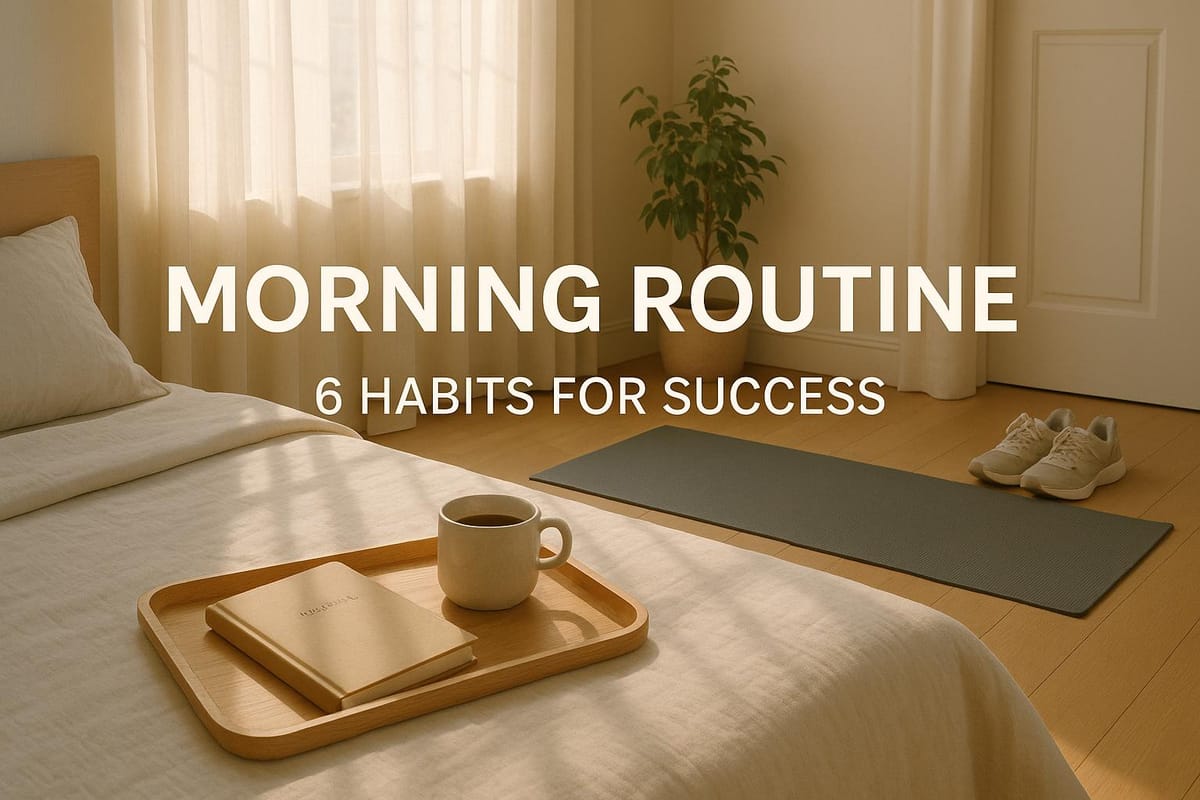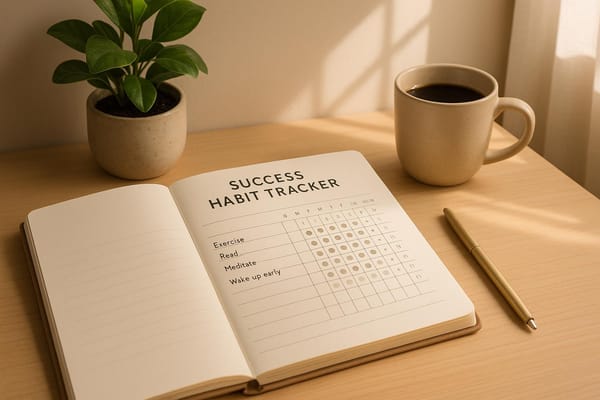Morning Routine: 6 Habits for Success
Explore six effective morning habits that can enhance your focus, productivity, and overall well-being for a successful day ahead.

Want to start your day feeling focused and productive? A solid morning routine is your secret weapon. Research shows that consistent habits can reduce stress, improve focus, and set the tone for a successful day. Here’s a quick breakdown of six key habits to build a powerful morning:
- Wake up early: Consistent wake times improve energy and mental sharpness. Adjust slowly - 10-15 minutes earlier every few days.
- Move your body: Even 5-10 minutes of exercise boosts energy and mood. Try stretches, yoga, or a quick workout.
- Practice mindfulness: Spend 2-3 minutes on deep breathing, meditation, or journaling to reduce stress and stay present.
- Set daily goals: Identify 3-5 key tasks. Time-block your schedule for better focus and productivity.
- Eat a balanced breakfast: Include protein, complex carbs, and healthy fats for sustained energy.
- Track your progress: Use a habit tracker or journal to reflect on wins and areas to improve.
These steps don’t require a total life overhaul - small, consistent actions can lead to big changes over time. Start with one or two habits, and build from there. Your morning routine is your foundation for a productive, fulfilling day.
12 Good Morning Routine Habits of the World’s Most Successful People
Get Up Early and Keep It Up
Getting up early gives you a calm hour before the busy day starts. Those still morning times are great to look after yourself with no calls, emails, or others asking for help. You don't have to start getting up at 5:00 AM right away - it's about picking a time that works for you and keeping to that.
The true good stuff happens when you keep it up. Getting up at the same time every day helps your body clock work better. This habit not only makes you feel more awake but also helps in slowly changing how you sleep.
"By waking up at a consistent time every day, it helps set our body's clock, known as the circadian rhythm, which also helps us feel sleepy at the same time every day and have a sufficient window of time for sleep." - Julia Kogan, health psychologist at the Department of Veterans Affairs
Studies show this is true. People who sleep on set times have a 30% less chance of dying early and a 38% less chance of heart issues. Work output also drops when sleep lacks - those with only five to six hours of sleep are 19% less able to do well, and this rate goes up to 29% for those with less than five hours, compared to those who sleep seven to eight hours.
Change When You Wake Up Slowly
If you want to change when you wake up, do it bit by bit. Change by 10-15 minutes every 2-4 days to let your body get used to it and keep from feeling too tired.
"The best method for changing the time you wake up is to do it gradually -- 10-15 minutes earlier for 2-4 days, until you feel used to it, and then repeat." - Leo Babauta
Set your alarm to ring 10-15 minutes early and keep it that way for some days. When you're okay with that, set it back another 10-15 minutes. Going slow makes it less hard to deal with big changes.
Make mornings fun. Plan a small treat for yourself early on - like enjoying a quiet coffee, a bit of a book, or going out to feel the fresh air. When you have something nice to do, it's easy to get up.
Use light well. Open your curtains or blinds right when you wake to bring in sunlight. Being in bright light for 15-30 minutes early in your day helps keep your body's clock in check. If it's still dark, use a light box or bright lamp to tell your brain it's time to wake.
Don't sleep in too much on weekends. Try to sleep only an hour more than usual. Too much sleep can mess up the good habits you built in the week.
When you keep to a set wake-up time, you start to sleep regularly - this is key to keeping up your mind and body strength each day.
Why a Regular Sleep Schedule Matters
Keeping to a sleep time helps you wake up fresh and keeps you healthy. Waking at different times each day is like causing your own jet lag without going anywhere.
"Humans really love to have a routine. Having your circadian rhythm all over the place leads to sleep deprivation and mental disarray." - Christine Stevens, sleep consultant and founder of Sleep Solutions by Christine
Going to bed and waking up at the same time each day helps with learning, remembering, and staying sharp all day. It makes you feel better, lets you focus better, and helps with dealing with stress.
Sleeping at odd times, though, can lead to more stress, while sleeping well boosts your immune system, brightens your mood, and improves how well you think. Instead of feeling tired in the afternoon, you’ll feel awake and ready for the day.
Dealing with stress gets easier when your body knows what's coming. A steady routine brings a sense of calm, making it simpler to tackle things you didn't plan for.
Sleep pro Michelle Drerup has words of hope for you if you want to start:
"Changing habits is challenging, but when someone is motivated to make this change and puts forth intention and effort consistently, you typically can reset your sleep schedule to an earlier morning wake time." - Michelle Drerup, PsyD, psychologist and director of the Behavioral Sleep Medicine Program at the Cleveland Clinic
To keep up with your new wake-up time, set up a night plan. Begin to slow down two hours before bed by turning off screens and going for calm things like reading or easy stretching. These soothing acts tell your body that it's time to get ready for sleep, making you wake up fresh and set to face the day.
Move: Get Energy and Clear Your Head
Begin your day with some action, and you'll find you have more energy and focus. A quick run or some stretches in the morning wakes up your body, makes your mind sharp, and sets off endorphins - those things in your body that lift your mood and make you feel good. And don't stress - this doesn't mean you have to join a gym or sweat for an hour. Just 5-10 minutes of moving your body can change how you feel in a big way.
"Starting your day with exercise can set a positive tone for your day. Morning workouts not only wake you up but also give you a sense of accomplishment that can carry you through whatever challenges come your way."
– Marshall Area YMCA
One more plus? Workouts in the morning cut down on the risk of distractions later. Things like meetings, jobs, or time with family can mess up plans to stay fit later in the day. But if you move your body first thing, you make sure it happens.
"Exercising in the morning ensures that you don't interrupt your workout schedule and get too busy with other daily items such as work, running errands, preparing meals, and spending time with family in the evenings."
– Performance Health
Simple Moves You Can Do Anywhere
Just start - easy moves like jumping jacks, high knees, and squats can lift your mood fast. Workout in a tight spot or need to be easy on your joints? Change these moves up. Like, step side to side instead of jumping or walk on the spot instead of high knees.
The O'Coach Fitness App has a quick tip for a two-minute mood boost: do 30-second bursts of jumping jacks, side bends, high knees, and squats. This short drill is made to wake you up and sharpen your mind.
Want to get strong? Try push-ups, planks, and lunges. Not set for full push-ups yet? Start with wall or knee push-ups and slowly step it up. Moves like planks or standing side bends can make your back straight and balance better, making you feel firm all day.
Yoga and stretches are great for mixing body work with calm thoughts. Some quick sun salutations or easy stretches can make you feel calm and set for your day.
Here’s a list of moves that are good for small places:
| Exercise | Description | Space Needed |
|---|---|---|
| High Knee March | Easy move, helps with staying steady | Small space |
| Modified Jumping Jacks | Step, don't jump, eases knee pain | Small space |
| Side-to-Side Steps | Gets heart going, makes hips stronger | 3–4 feet across |
| Standing Side Bends | Works middle, mild heart work | Small space |
| Squat and Punch | Mixes power and heart work | 3×3 feet |
The squat and punch is great for small spots. In 2023, a study by Train with Dave showed it cuts knee stress by 40% when put up against jump squats. It also keeps your heart rate at 65–75% of its top speed. Also, a person who weighs 150 pounds can burn around 8–10 calories each minute doing this move [Train with Dave OC].
"The important thing is to just go for it and don't let anything hold you back."
– Rob Cox, Studied Organizational Behavior & Psychology
Start with just a bit. Even 10 to 15 minutes can help. As you get used to it, make it harder. Get your gear ready the night before and plan what you will do. Drink water first thing when you get up, and try playing lively music or let sunlight in.
Keep Track of Your Wins in Easy Ways
Once you start, keeping an eye on your wins helps you keep going and feel good. It's easy - here are simple ways to watch your work:
- Time-based aims: Write down how many minutes you move each morning. From 5 minutes of stretching to 15 minutes of body weight moves, watching your time grow each week is a good push.
- Count steps: If your plan includes walking, use a step counter. Many phones can do this, or get a simple step watch. A quick walk in the morning can mean 1,000 to 1,500 steps more each day.
- Check energy and mood: Rate how you feel on a 1-10 scale before and after you move. This easy check can show how moving helps your mind and mood.
- Track actions: Note how many push-ups, squats, or seconds you hold a plank. Seeing this number rise over time can push you to do more.
- Keep a streak: Put an "X" on your calendar each day you move. This streak can keep you moving, even when it's hard to start.
Celebrate when you move, even just 10 minutes, three times a week - that’s a win. Keep at it - showing up, even on tough days, is what helps you reach bigger aims later in life.
Make Time for Mindfulness to Focus and Cut Stress
When you wake up and start your day, take a bit to calm your mind. Mindfulness can keep you in the now, help stress fade, and free your thoughts. This sets you up for a day of good work.
The morning is a top time for mindfulness as your mind is still clear. Just taking two to three minutes daily can change things. Studies show that even short daily mindfulness sessions for eight weeks better attention, memory, mood, and control over feelings. Also, mindfulness has ties to more self-knowing, less overthinking, and a stronger memory to work with. As time goes by, these gains can change how you deal with hard times, adding good value to your morning.
Easy Mindfulness Steps for Starters
If you’re new to this, pick methods that fit easy into your day. Here are some simple ways to bring mindfulness into your morning routine:
Deep Breathing
This is an easy start. Breathe in through your nose for four counts, hold for one count, and breathe out through your mouth for five counts. If you're not sure how to start, look for guided breathing videos online.
"We're looking at our thoughts and feelings with curiosity, gentleness, and kindness." – Dr. Eric Loucks, Director of the Mindfulness Center at Brown University
Body Scan Meditation This way of bringing you peace has you pay mind to how your body feels. Start at your toes and go up to your head, just noting any tight spots or feelings but don't try to change them. This can be easier for new people to do with the help of voice guides.
Mindful Journaling Take a bit of quiet time each day to write out your thoughts and emotions. You might also like gratitude journaling, where you say thanks for three things.
Progressive Muscle Relaxation This method helps cut down on body stress by making muscles tight then loose, from your feet up.
Imagery Exercises Think of a calm spot, like a still beach or a quiet woods, as you take deep breaths. Focus on what you see, hear, and feel in your mind's place.
Gentle Stretching or Yoga Move and keep aware by thinking about your breath and how your body feels as you stretch. This helps make the step from moving a lot to feeling calmer.
"Developing the skill of mindfulness can help stop you from being pulled into any one thought and carried down the stream." – Dr. Sona Dimidjian, University of Colorado Boulder
Make Mindfulness a Daily Thing
To keep mindfulness in your day, start small and keep at it. Pick one way that works for you and do it at the same time each day. Link mindfulness to a habit you already have - like deep breathing as your coffee makes or a body check before you get up - this can help it stick.
Use reminders to keep your practice strong. Set phone alerts, put reminders in your calendar, or put notes where you can see them. Some folks make triggers, like three deep breaths every time they sit at their desk.
Focus on one thing - like your breath, a sound, or something you see. When your thoughts drift, gently guide your focus back to that thing.
Begin your day with a quiet start. Before you grab your phone or start your tasks, sit calm for a bit. Breathe deep and think of what you want from the day. Mixing mindfulness with setting goals can help you keep sharp and makes the step from sleep to daily noise smoother.
Set Your Day's Goals and Important Work
After some mind calm, get ready to plan your day on purpose. Going from peace to action starts with making clear goals for each day. This helps you deal with your day by acting first, not just reacting to what comes. With set key work, you cut down on too many choices and make sure big tasks are done first. It's like turning a quiet morning into a map for getting things done.
Without a set plan, you can lose focus due to things like social media, emails, or other small needs. But with clear goals, you keep on what really counts. Studies show that people who make real goals are 10 times more likely to reach them than those who don’t.
Big-time leaders love this step. For example, Kenneth Chenault, once head of American Express, ends his nights by noting down three main jobs for the next day. This small night act makes sure he starts his days with a target. Using this way means you start meaningful work fast without losing time on what you should do.
To make it work, keep your goals clear and doable. You don't need a big plan - just a clean list of what you hope to do and when. This method keeps you moving right on what needs doing.
Make a Clear Task List
A smart task list can shape your whole day. Keep it short, exact, and centered on big things. Pick 3-5 main tasks that fit your big goals. Too many things on your list can make you feel lost or too busy.
State your tasks in clear, doable ways. For instance, don't just write "work on project", but "write project plan" or "end client talk by 11:00 AM." This kind of clear task makes it easy to see your progress and know when you’re done.
Put your list in order and do the most vital task first when you’re most awake. This way, if something comes up later, you’ve already moved ahead on important stuff.
Here are some clear daily goals you can set:
- End client talk by 11:00 AM
- Be at 10:00 AM group talk
- Use 30 minutes on learning more in your job
- Have a 20-minute walk before lunch
These goals are exact, time-limited, and doable, making them easier to hit and track.
You can write your task list at night or at the start of the day - whatever fits best for you. The main point is to keep to the plan that works for you.
Plan Your Day With Time Blocks
Once you have your tasks set, give each one a certain time with time-blocking. This method lets you focus on one thing at a time and avoids the traps of trying to do many things at once.
To start, use a book planner or a digital calendar to mark time for each job. For example:
- 8:00-9:00 AM: Reply to emails
- 9:00-10:30 AM: Main project work
- 10:30-11:00 AM: Team talk
- 11:00 AM-12:00 PM: Calls with clients
Time-blocking sets up a clear plan that’s easy to use and holds you to it. When you know what time to work on things, you’re less apt to delay or lose focus.
Tools like Google Calendar, Microsoft Outlook, and Todoist help a lot with time-blocking, offering simple setups that work well with common AM/PM timing. If you like pen and paper more, planners like the Full Focus Planner have good layouts made for this style.
Make sure to put breaks between tasks. These help you deal with surprises or jobs that need more time. If something big comes up, you can change your plan without messing up your whole day.
The goal is not to control each minute but to make a plan that lets you stay on track. With a clear plan, you’ll waste less time picking what to do next and use more time doing your work.
If you're just starting with time-blocking, begin small. Start by planning your top three things, then slowly add more rules as it gets easier. Aim for regular progress, not for being perfect.
Have a Good Breakfast to Start Your Day Right
When you've laid out your plans, it's time to give your body the push it needs to work well. A good breakfast does more than just fill your belly - it sets up your whole day. The right foods can give you the power and clear mind you need to meet your aims.
A good breakfast must have three key parts: protein, complex carbs, and good fats. These elements keep your power level even and stop the bad mid-morning low that can come from a sweet or heavy carb meal. Experts say that breakfast should make up 20-35% of your daily energy use.
"Eating a nutritious and balanced breakfast can help jumpstart your energy for the day while keeping you full and focused as you work, play, or create." - Tiffany La Forge
The right kind of breakfast does more than fill you up - it also levels out your blood sugar. Eat slow carbs with protein and good fats to keep you full of energy all morning.
Healthy Breakfast Tips
Putting together a good breakfast is easy. Begin with protein-rich foods like eggs, which have 6 grams of protein, 5 grams of fats, and just 75 calories each. Low-fat cottage cheese is also good, giving you 14 grams of protein for every ½ cup.
Greek yogurt is great too. It has magnesium, calcium, and B vitamins that help make energy. Mix in fresh berries or slices of banana for good carbs, or blend it in a smoothie with green veggies for more iron and stuff that's good for you.
For something with fiber, try oatmeal. A ½ cup of oats made with a cup of milk or water has carbs, fiber, and nutrients like B vitamins and iron. Add a spoon of flaxseed and some nuts or nut butter for more taste and health.
If mornings are busy, think about these make-ahead choices:
- Overnight oats: Mix ½ cup oats, ½ cup milk, 1 spoon chia seeds, and your liked fruits. Put in the fridge overnight for an easy morning meal.
- Egg muffins: Beat 6 eggs with ¼ cup milk, pour into muffin cups, add veggies and cheese, and bake at 350°F for 20 minutes.
- Breakfast burritos: Mix up eggs with black beans, cheese, and veggies, then put in whole wheat wraps. Freeze them for an easy warm-up meal.
Avocado toast is a simple pick too. Spread smashed avocado on whole-grain bread. It has fiber, good fats, and B vitamins. For more protein, put a poached egg on top or add tomato slices and hemp seeds.
Smoothies are a fast way to start your day. Try blending 1 cup of spinach, ½ banana, ½ cup Greek yogurt, 1 spoon almond butter, and ¾ cup unsweetened almond milk for a green smoothie full of goods.
And don’t skip out on water - it's as key as your meal.
Start With Water
Before coffee or food, drink 8–16 ounces of water to rehydrate after sleep. This simple step helps digestion, boosts your metabolism, and wakes you up. A slice of lemon adds a refreshing vitamin C.
Studies say drinking water on an empty stomach can up your metabolism by as much as 30% for around 30–40 minutes. Warm water might help digestion by waking up your stomach before food.
To keep it simple, put a reusable water bottle by your bed. If you’re hungry when you wake, drink some water first - thirst can seem like hunger. Even a small drop in water in your body, like 1–2%, can mess with your focus. Keep drinking water as you get and eat breakfast to stay hydrated and help your digestion as you start your day.
Check How You're Doing
After you start your day with a good meal and some water, stop for a bit to check how your morning plan is going. This fast look lets you spot what’s good, what’s bad, and what you might need to fix. Thinking about how you're doing can really push you, making clear the parts you're doing great in and keeping your eye on your aims.
Often looking at your routine makes sure it fits with what you need now and how you live. Things change - work times move, family needs grow - and your mornings need to change too. As Benjamin Hardy points out, mornings should focus on doing, not getting. He suggests staying away from things that pull your attention early in the day:
"Don't check your social media or email until after your 3 hours of deep work. Your morning time should be spent on output, not input".
Being able to change is key. What works well in winter may not work in summer, so be ready to tweak things a bit.
Mark Sisson points out how key it is to start your day with a clear plan:
"When you lead with your own peace and well-being, however, much more is possible. Something essential changes when you begin directing your day rather than responding to it".
This active plan starts when you look ahead and make a plan, not just deal with things as they come.
To make sure these changes work, think about using easy tools to keep an eye on your path.
Use Habit Trackers or Journals
Habit trackers and journals help you watch your daily acts and spot trends in what you do. Whether it’s a book, a phone app, or a wall calendar, these tools let you see how well you stick to your plans.
For instance, a habit tracker can list your morning tasks up and down, with dates on top. Each time you do a task, put a check or an X. Soon, you will see which tasks you keep doing and where you need to try harder.
Writing in a journal takes it a step more by letting you think about your days. Take 2–3 minutes each morning to write how you feel, what went well the day before, and what you want to get better at. This habit can show how your actions impact your mood or energy.
Here's what to keep track of in your journal or habit tracker:
- Consistency: How much are you doing each habit?
- Energy levels: Do you feel full of energy on days you follow your plan?
- Challenges: What makes it tough to stick to your habits?
- Wins: What parts of your plan are doing great?
You can also use this time to think of small changes for the next day. Maybe you find that getting up 15 minutes earlier lets you have more time to calm your mind, or putting protein in your breakfast keeps you full longer.
Celebrate Small Wins to Stay Motivated
Keeping track of your path is not just about spotting what needs work - it's also about seeing your successes, even the tiny ones. Cheering for these wins keeps you pushing and builds up your drive over time. Each time you do your morning plan, you’re growing the self-control that leads to big wins.
These cheers don't have to be big. Give yourself a small treat that feels nice, like your best-loved coffee, a warm bath, or a new book. The key is to match the treat to the work and let it push you to keep going.
The wonder of this buildup is in adding up these small wins. Doing your plan for three days straight feels good. A full week feels even better. And after a month, you’ll find these tasks are now a simple part of your life.
Gains aren't always clear right away, so look for small signs of getting better. Maybe getting up early is still hard, but you manage to drink water first thing well. Or maybe your moments of calm are short, but you do them every day. These small acts grow bigger over time.
Remember, being flexible is key. If something seems wrong, fix it. The aim isn't to stick to a strict plan - it's to build habits that truly help your health and success. By cheering for small wins and being open to changes, you make a morning routine that sticks and helps you do well.
Taking time to often check and change makes sure your routine keeps being a solid base for a good and full day.
Make Your Morning Fit You
Your morning should help you, not hold you back. The six things we talked about - getting up early, moving, staying calm, making daily plans, eating well, and keeping track - work best when they fit your life, how much energy you have, and your day's plan.
Think of routines as bendy aids, not stiff musts. They are here to help you, not to trap you with hard set ideas. If your days tend to change a lot or if morning plans are hard to keep, don't worry - you're not by yourself.
Start by thinking on what helps you. What makes you feel alive in the morning? What makes you feel down? Maybe you're up and ready at 6:00 AM, or maybe you need 30 more minutes to wake up. Some people do well with 20 minutes of workout, while others are good with just 5 minutes of stretching.
If starting is hard, try the "Only 5 Minutes" way. Instead of going for a 30-minute workout, just move for 5 minutes. Pick 5 minutes of deep breathing over a long calm session. These small steps make habits less scary and help you keep going without too much stress.
Bring in new habits bit by bit. Start with something easy, like drinking a glass of water right when you wake up. Once that's easy, add another, like writing for 15 minutes or going for a fast walk. This slow way stops the all-or-none thinking and makes it easier to change your routine as life shifts.
For very busy mornings, try the Routine Menu Method. Split your tasks into two types: "must-dos" (like drinking water, taking deep breaths, or writing down a goal) and "extras" (like a longer workout or more writing). This lets you keep to what you need when time is tight and do more when you can.
Be real about your time. If you only have 15 minutes before work, don’t try to do an hour of things. Pick the tasks that boost your energy. For example, pick between working out and being calm or mix tasks, like stretching while your coffee is made. These tweaks let you run your day.
Plan ahead to ease your mornings. Put out your workout wear, get your breakfast ready, or set up your journal the night before. These small steps cut down on hard choices and make it simpler to keep to your morning plan.
If you often sleep in late, put your alarm far from your bed or go to bed earlier. If you miss breakfast because you're rushed, try quick stuff like overnight oats. And if being calm is tough with kids around, try doing it while they eat breakfast.
Be easy as plans may change. A daily plan that works when it is calm may need some changes when things get busy. Don't quit your habits; just change them to work better right now. For example, if mornings are too full, think about planning your goals at noon or working out at night. The aim isn't to pack it all into your morning - it's to make a plan that gets you ready for a good day.
While your plan is still new, use things like sticky notes, phone alarms, or lists to keep on the right path. Also, it’s good to get help from others. Tell your goals to friends or family, find a friend to work out with, or ask for some quiet when you need to focus. Support helps a lot when it's hard to keep going.
Most of all, go for being steady, not perfect. Missing a day doesn’t mean you fail. If you often wake at 6:00 AM but one day wake at 7:00 AM, you can still do a short form of your plan. The aim is to keep habits that stay, not to stick to a perfect plan every day.
As Hal Elrod, who wrote The Miracle Morning, puts it:
"By simply changing the way you wake up in the morning, you can transform any area of your life."
Your morning plan should give you energy and be easy to keep up - not feel like a task. Start with little steps, think real about your time and power, and change if you must. The top routine is the one that fits well into your day.
Last Part: 6 Ways to Make Your A.M. Best
To set up a strong morning plan, you need six steps. They kick-start a day that is busy and good. Get up early, move, think calm thoughts, know your day's goals, eat a good meal, and see your wins. These acts make the base for you to grow in all areas of life.
These steps do more than just fill up your morning. They start a push forward. Getting up early lets you have quiet time before busy hours hit. Moving makes you feel upbeat and ready; in fact, a study from the University of Bristol shows that moving every day makes you feel more awake and happy all day. Calm thoughts cut stress and sharpen focus, while goals for the day give you a clear path. All these things together help make a plan that keeps you going strong.
Eating well in the morning is also key, as it gets your brain ready to make good choices. Studies say a good meal can boost memory, focus, and how well you solve problems. And, seeing your growth keeps you driven and shows how much you've done.
Staying with it is how you make these steps part of your life. Studies show that people who get up early tend to put off less. But the best plan is one that fits your life and feels right for you.
Thomas Oppong says it best:
"Starting and maintaining a positive morning routine is an investment of a lifetime. It gives you structure, builds life-changing habits, and creates momentum for the rest of your day."
Your daily plan should make you feel alive, not swamped. Begin with little steps - choose one or two easy habits and grow slowly. It does not matter if you have 15 minutes or a whole hour, these six habits can fit into your time. By turning mornings into your starting point, you make a large move toward the life you dream of.
FAQs
What’s the best way to adjust my wake-up time without feeling exhausted?
To shift your wake-up time without feeling exhausted, try adjusting your alarm gradually. Move it earlier by just 10 to 15 minutes every 2 to 4 days. This slow progression gives your body the chance to adapt, minimizing the likelihood of grogginess.
Pair this with a consistent bedtime and a relaxing nighttime routine - whether it’s reading, meditating, or simply unplugging from screens. These habits can improve your sleep quality and help your body sync with its natural rhythm, making the change easier and more manageable.
What are some simple and healthy breakfast options for a busy morning?
If your mornings are a whirlwind of activity, having easy and wholesome breakfast options can make all the difference in keeping you fueled and focused. Here are a few ideas to simplify your mornings:
- Prep-ahead meals: Think overnight oats, egg muffins, or breakfast burritos - ready to grab straight from the fridge.
- On-the-go snacks: Options like yogurt parfaits, fresh fruit paired with nut butter, or a protein bar are perfect when you're rushing out the door.
- Fast smoothies: Blend up fruits, a handful of spinach, and a scoop of protein powder for a quick, nutrient-packed drink.
These options are not only convenient but also adaptable, letting you enjoy a nutritious start to your day without the stress.
How can I add mindfulness to my morning routine if I’m short on time?
Even with a packed schedule, it’s possible to weave mindfulness into your morning routine with a few simple, time-efficient practices. Take 2-3 minutes to focus on deep breathing, do a quick body scan, or try some mindful stretches to ground yourself. You can also set a consistent wake-up time and kick off your day with a moment of gratitude or by setting a clear intention.
These small steps can help you cultivate a calm and focused mindset, setting a positive tone for the rest of your day - without taking up much of your time.





